I've heard electret microphones are usually what's in a smartphone, but I've never heard about them. Is it the most common type or is it condenser or dynamic? Or a mixture of the three?
-
I don't know, but based on the device type I think major ones are electret mics. Some, if not major microphone that connects directly to mic input on desktops are electret, maybe you know. http://en.wikipedia.org/wiki/Electret_microphone – Diego C Nascimento Jul 22 '14 at 05:00
-
It is all electret microphones in this sort of equipment. Check the introductory video's on EEVblog that discuss the difference between dynamic and electret: http://www.youtube.com/playlist?annotation_id=annotation_4208981081&feature=iv&list=PLvOlSehNtuHv98KUcud260yJBRQngBKiw&src_vid=e5xenXTwAzo – jippie Jul 22 '14 at 05:31
-
2Or these days, possibly [MEMS microphones](http://www.st.com/web/catalog/sense_power/SC1564). – Damien Jul 22 '14 at 07:49
-
I would not say all until some one opens or post some schematic or prof. Why not a audio focused smart phone with a good condenser mic? it can even be in the shape of old condensers. :) – Diego C Nascimento Jul 22 '14 at 09:44
1 Answers
The electret microphone is used but is rapidly being replaced by a MEMS type which has a much flatter profile and can be surface mounted to the pcb.

A MEMS microphone is a condenser type microphone that comprises a MEMS die and a complementary metal-oxide-semiconductor (CMOS) die combined in an acoustic housing. (The gap is about 4um giving a capacitance in the region of about 0.5pF)). The CMOS often includes both a preamplifier as well as an analog-to-digital (AD) converter.
The electret is small, light, cheap but with good sensitivity and frequency range. Essentially it is the first cousin to the condenser microphone. Both operate by forming a 'condenser' or plate capacitor. The sound (pressure) changes the plate gap altering the capacitance value (as it does in the MEMS). These changes in capacitance alter the voltage across the plates which follow the sound pressure changes.
In the electret microphone one of the plates is made from a polarised (charged) insulator (electret). This means that no external high voltage (a few hundred voltage) is needed to charge the plate. Both types are very high impedance and require some form of buffering/impedance changing circuit. In the case of the electret this is built into the microphone using a JFET. In the case of the MEMS the circuit is integrated into the CMOS structure of the microphone.
The dynamic microphones generate their own electrical signal. Generally these are electro-magnetic types with low impedance outputs (a few hundred ohms).
- 18,926
- 30
- 40
-
Thank you, Jim. That was exactly what I was looking for plus some things I need to know that I didn't know I didn't know. – user49830 Jul 22 '14 at 21:35
-
@Jim Deargen I would like to ask you, do you by any chance know the diameter of the diaphragm of the typical MEMS microphone used in smartphones? – VMMF Aug 11 '17 at 13:34
-
1@VMMF this may help to fill in the detail. http://www.st.com/content/ccc/resource/technical/document/application_note/46/0b/3e/74/cf/fb/4b/13/DM00103199.pdf/files/DM00103199.pdf/jcr:content/translations/en.DM00103199.pdf the microphones are approx 4 x 3mm or the smaller version 2x3 mm – JIm Dearden Aug 20 '17 at 10:12
-
@Jim Deargen Thanks. I've seen pictures of MEMS diaphragms of only 0.5 mm. Would you mind contributing here: https://electronics.stackexchange.com/questions/323938/polar-pattern-of-typical-speakers-and-microphones-found-in-smartphones – VMMF Aug 21 '17 at 13:26